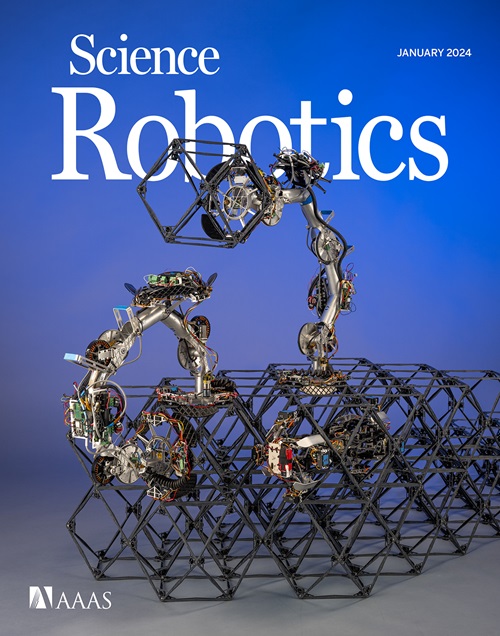基于单层软皮和高密度电阻抗层析成像的多模态信息结构
IF 27.5
1区 计算机科学
Q1 ROBOTICS
引用次数: 0
摘要
人体皮肤可以可靠地捕获大表面上的各种多模态数据,同时提供软界面。使用微机电系统(MEMS)的人工技术可以模拟这些生物功能,但在制造,由于软刚性界面和电干扰而导致的分层方面存在许多挑战。为了解决这些困难,我们提出了一种单层多模态感觉皮肤,仅使用高度敏感的水凝胶膜。利用电阻抗断层扫描技术,我们在细胞膜上访问了多达863,040条导电通路,使我们能够识别至少六种不同类型的多模态刺激,包括人类触摸、损伤、多点绝缘按压和局部加热。通过全面的物理测试,我们证明了来自这些路径的高度冗余和耦合的感官信息可以使用数据驱动技术进行结构化,选择应该监测哪些路径以实现有效的多模态感知。为了展示我们的方法的多功能性,我们将水凝胶浇铸成成年人手的形状和大小。利用我们的信息结构策略,我们展示了手预测环境条件、定位人类触摸和生成本体感觉数据的能力。我们的框架解决了在多模态软测量中物理提取有意义信息的挑战,为敏感系统中以信息为主导的单层皮肤设计开辟了新的方向。本文章由计算机程序翻译,如有差异,请以英文原文为准。
Multimodal information structuring with single-layer soft skins and high-density electrical impedance tomography
The human skin can reliably capture a wide range of multimodal data over a large surface while providing a soft interface. Artificial technologies using microelectromechanical systems (MEMS) can emulate these biological functions but present numerous challenges in fabrication, delamination due to soft-rigid interfaces, and electrical interference. To address these difficulties, we present a single-layer multimodal sensory skin made using only a highly sensitive hydrogel membrane. Using electrical impedance tomography techniques, we accessed up to 863,040 conductive pathways across the membrane, allowing us to identify at least six distinct types of multimodal stimuli, including human touch, damage, multipoint insulated presses, and local heating. Through comprehensive physical testing, we demonstrate that the highly redundant and coupled sensory information from these pathways can be structured using data-driven techniques, selecting which pathways should be monitored for efficient multimodal perception. To demonstrate our approach’s versatility, we cast the hydrogel into the shape and size of an adult human hand. Using our information structuring strategy, we demonstrate the hand’s ability to predict environmental conditions, localize human touch, and generate proprioceptive data. Our framework addresses the challenge of physically extracting meaningful information in multimodal soft sensing, opening new directions for the information-led design of single-layer skins in sensitive systems.
求助全文
通过发布文献求助,成功后即可免费获取论文全文。
去求助
来源期刊

Science Robotics
Mathematics-Control and Optimization
CiteScore
30.60
自引率
2.80%
发文量
83
期刊介绍:
Science Robotics publishes original, peer-reviewed, science- or engineering-based research articles that advance the field of robotics. The journal also features editor-commissioned Reviews. An international team of academic editors holds Science Robotics articles to the same high-quality standard that is the hallmark of the Science family of journals.
Sub-topics include: actuators, advanced materials, artificial Intelligence, autonomous vehicles, bio-inspired design, exoskeletons, fabrication, field robotics, human-robot interaction, humanoids, industrial robotics, kinematics, machine learning, material science, medical technology, motion planning and control, micro- and nano-robotics, multi-robot control, sensors, service robotics, social and ethical issues, soft robotics, and space, planetary and undersea exploration.
 求助内容:
求助内容: 应助结果提醒方式:
应助结果提醒方式:


